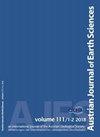北阿尔卑斯前陆盆地(奥地利)上始新世碎屑储集岩中的碳酸盐胶结作用
IF 1.1
4区 地球科学
Q2 Earth and Planetary Sciences
引用次数: 3
摘要
北高寒前陆盆地始新统上储层碳酸盐沉积与微生物生气之间存在明显的密切关系。为了更好地理解这种关系,研究了40个湖盆到浅海、含气、含油和含水砂岩样品,以确定矿物学和成岩历史。利用特定的共生矿物重建了水文地球化学条件随时间的变化。因此,储层岩石中的自生矿物相是重建孔隙流体组成变化的重要资料。始新统砂岩的成岩孔隙空间演化受原生矿物学的影响,主要受沉积环境、碎屑输入和搬运距离的控制。因此,低成分成熟度与高长石和高粘土矿物含量有关。自生粘土矿物是在成岩作用的几个阶段形成的,由于孔隙空间缩小,对储层质量起着重要作用。在成矿过程中,自生泥晶相和空间质碳酸盐相沉积,使孔隙空间减小。这些古成因碳酸盐胶结物的同位素值约为δ C: -5.9 ~ +2.2‰,O: -8.3 ~ -4.3‰[VPDB]。部分样品的δ O值呈较轻的趋势(-17.2‰),这是由于大气冲刷所致。始新统砂岩内可划分出两类低渗透强胶结带:(1)硫酸盐高级还原阶段有机质降解形成的超轻δ C(-28.4‰)碳酸盐;(2)发酵期沉淀形成的重δ C(+8.7‰)碳酸盐。在储层砂岩中,成岩作用以矿物不稳定(如碳酸盐和长石腐蚀)和高岭石沉淀为特征。自生高岭石小卷的形成导致孔隙度降低。_____________________ ________________________________________________ ____________________________ ______________________________________ ________________ 13 18δ奥地利维也纳地球科学杂志》DOI: 10.17738 / ajes.2017.0005 1) *)(1)(1) 1) 1)玛丽GRUNDTNER,多丽丝,总值Reinhard格拉茨,莱因哈德·大卫·米诗SACHSENHOFER &本文章由计算机程序翻译,如有差异,请以英文原文为准。
Carbonate cementation in Upper Eocene clastic reservoir rocks from the North Alpine Foreland Basin (Austria)
A strong relationship between carbonate precipitation and microbial gas generation is evident for the Upper Eocene reservoir rocks of the North Alpine Foreland Basin. To achieve a better understanding of this relationship, 40 samples of limnic to shallow marine, gas-, oiland water-bearing sandstones were studied to determine mineralogy and diagenetic history. The specific mineral parageneses were used to reconstruct changes in the hydrogeochemical conditions over time. Thus, authigenic mineral phases within reservoir rocks are an important archive for the reconstruction of pore fluid composition changes. The eogenetic pore space evolution of investigated Eocene sandstones is influenced by their primary mineralogy, which is strongly controlled by (i) depositional environment, (ii) detrital input and (iii) transport distances. Thus, a low compositional maturity is associated with high feldspar and high clay mineral content. Authigenic clay minerals, formed during several stages of diagenesis, play an important role for reservoir quality, due to pore space reduction. During eogenesis, authigenic micritic and sparitic carbonate phases are precipitated, which decreases the pore space. These eogenetic carbonate cements exhibit isotope values of about δ C: -5.9 to +2.2‰ and O: -8.3 to -4.3‰ [VPDB]. Some of these sam18 ples indicate a trend towards lighter δ O values (-17.2‰), which is attributed to meteoric flush. Within the Eocene sandstones, two types of strongly cemented zones with low permeabilities can be differentiated: (i) extraordi13 nary light δ C (-28.4‰) carbonates, which formed due to degradation of organic matter at the stage of advanced sulfate reduc13 13 tion and (ii) heavy δ C (δ C: +8.7‰), which precipitated at the fermentation zone. Within the reservoir sandstones telogenesis is characterized by mineral destabilization (e.g. carbonate and feldspar corrosion) and kaolinite precipitation. The formation of authigenic kaolinite booklets resulted into a decrease in porosity. _____________________ ________________________________________________ ____________________________ ______________________________________ ________________ 13 18 δ Austrian Journal of Earth Sciences Vienna DOI: 10.17738/ajes.2017.0005 1)*) 1) 1) 1) 1) Marie-Louise GRUNDTNER , Doris GROSS , Reinhard GRATZER , David MISCH , Reinhard F. SACHSENHOFER &
求助全文
通过发布文献求助,成功后即可免费获取论文全文。
去求助
来源期刊

Austrian Journal of Earth Sciences
Earth and Planetary Sciences-Paleontology
CiteScore
3.10
自引率
0.00%
发文量
0
审稿时长
>12 weeks
期刊介绍:
AUSTRIAN JOURNAL OF EARTH SCIENCES is the official journal of the Austrian Geological, Mineralogical and Palaeontological Societies, hosted by a country that is famous for its spectacular mountains that are the birthplace for many geological and mineralogical concepts in modern Earth science.
AUSTRIAN JOURNAL OF EARTH SCIENCE focuses on all aspects relevant to the geosciences of the Alps, Bohemian Massif and surrounding areas. Contributions on other regions are welcome if they embed their findings into a conceptual framework that relates the contribution to Alpine-type orogens and Alpine regions in general, and are thus relevant to an international audience. Contributions are subject to peer review and editorial control according to SCI guidelines to ensure that the required standard of scientific excellence is maintained.
 求助内容:
求助内容: 应助结果提醒方式:
应助结果提醒方式:


